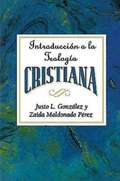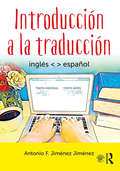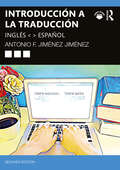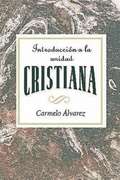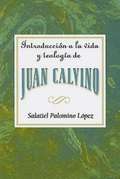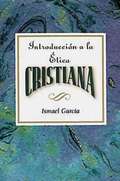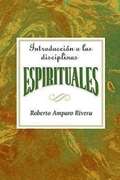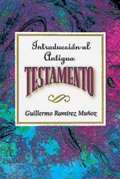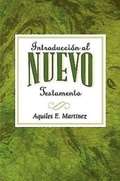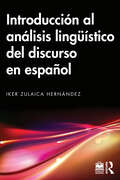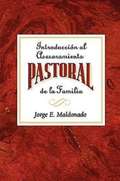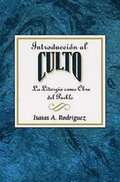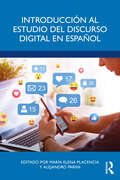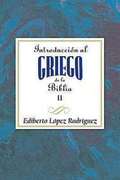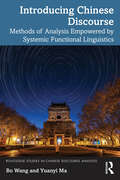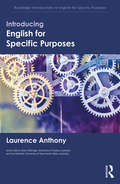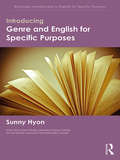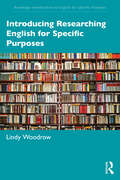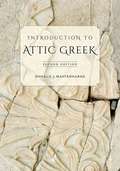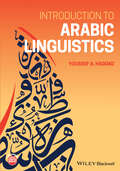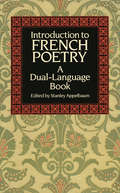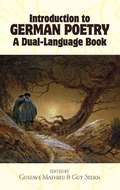- Table View
- List View
Introducción a la teología cristiana AETH: Introduction to Christian Theology Spanish
by Justo L. Gonzalez Abingdon PressUna clara, concisa y atrayente introducción a un campo que esta regresando una vez mas, especialmente entre los laicos comprometidos con el renovado interés en el crecimiento espiritual dentro del contexto de una tradición eclesiástica. Como historiadores del cristianismo, los autores de este libro ofrecen una introducción a las doctrinas cristianas tradicionales. Escrito en un estilo claro directo, este libro presenta una reseña de las raíces, los contextos particulares, y los entendimientos doctrinales de temas como la teología, Dios, el ser humano, Jesucristo, la iglesia, y la esperanza.A clear, concise and attractive introduction to a field that is returning once again, especially among the laity committed to the renewed interest in spiritual growth within the context of church tradition. As historians of Christianity, the authors of this book provide an introduction to traditional Christian doctrines. Written in a direct style, this book provides an overview of the roots, contexts, and understandings of issues of doctrine and theology, God, man, Jesus Christ, the church, and hope.
Introducción a la traducción: inglés - español
by Antonio F Jiménez JiménezEste manual introduce al lector a la actividad de la traducción de inglés a español y viceversa, adoptando un punto de vista práctico y siguiendo los estándares profesionales actuales.? Introducción a la traducción examina una gran variedad de temas enfocados en resolver los problemas de traducción que se suelen encontrar en los textos, por ejemplo, en relación a los elementos culturales, los aspectos connotativos, la variación lingüística, la traducción subordinada y la traducción especializada. Para ello, se exploran detenidamente, y con multitud de ejemplos prácticos, las técnicas, estrategias y herramientas disponibles durante la actividad traductora. La página web que acompaña a este manual incluye además información lingüística contrastiva entre el inglés y el español para evitar problemas de transferencia negativa entre ambos idiomas.? Introducción a la traducción aumentará la competencia traductora de los lectores de una manera sistemática, coherente y contextualizada, ofreciendo oportunidades de práctica a través de un gran número de actividades y textos para traducir.? ? This manual introduces readers to the activity of Spanish-English/English-Spanish translation while adopting a practical perspective aligned with current professional standards.? Introducción a la traducción examines a wide variety of topics that focus on resolving common problems that tend to arise throughout the process of translating different kinds of texts. For example, this book explores translation issues with respect to cultural elements, connotative meaning, linguistic variations, constrained translation and specialized translation. It offers a multitude of practical examples and a thorough consideration of the techniques, strategies and tools available to translators. Among other resources, the companion website includes contrastive linguistic analysis of English and Spanish to help avoid negative transfer issues between both languages.? Introducción a la traducción will improve the reader’s competence as a translator in a systematic, coherent and contextualized way, providing abundant opportunities to practice translation skills through ample hands-on activities and a wide variety of texts to translate.
Introducción a la traducción: inglés < > español
by Antonio F. Jiménez JiménezAhora en su segunda edición, este manual introduce al lector a la actividad de la traducción de español-inglés/inglés-español, adoptando un punto de vista práctico y siguiendo los estándares profesionales actuales. Integrando los últimos avances en la profesión de la traducción con sólidos enfoques pedagógicos, Introducción a la traducción explora las competencias necesarias durante el proceso de traducción; desde el conocimiento de las lenguas y las culturas hasta la comprensión de la traducción como actividad y como producto, a través de una diversidad de tipos textuales. Cada lección cuenta con una gran cantidad de actividades y ejercicios prácticos. Esta nueva edición ofrece más actividades, más ejemplos que reflejan las variedades de español de Latinoamérica, contenidos ampliados y nuevos temas de actual relevancia, como la interpretación a distancia, la localización, la traducción automática y la inteligencia artificial. Los estudiantes aumentarán su competencia traductora de una manera sistemática, relevante y contextualizada. En esta segunda edición, se han aumentado los recursos disponibles en la página web del manual, incluyendo nuevas presentaciones de PowerPoint y herramientas de evaluación para los instructores, así como más textos para la práctica de la traducción para los estudiantes. Now in its second edition, this manual introduces readers to the activity of Spanish-English/English-Spanish translation, while adopting a practical perspective aligned with current professional standards. Integrating the latest developments in the translation profession with solid pedagogical approaches, Introducción a la traducción explores the competencies needed during the translation process; from knowledge about the languages and cultures, to understanding translation as an activity and as a product through a diversity of text types. Each lesson provides ample practice through hands-on activities and exercises. This new edition offers more activities, more examples relevant to Latin American varieties of Spanish, expanded content, and coverage of contemporary topics, such as remote interpreting, localization, machine translation, and artificial intelligence. Students will increase their translation competency in a systematic, meaningful, and contextualized way. In this second edition, the companion website provides additional resources, including new PowerPoint presentations and assessment tools for instructors, and more texts for translation practice for students.
Introducción a la unidad cristiana AETH: Introduction to Christian Unity Spanish
by Association for Hispanic Theological EducationIntroduccion a la unidad cristiana
Introducción a la vida y teología de Juan Calvino AETH: Introduction to the Life and Theology of John Calvin
by Association for Hispanic Theological EducationEste libro del Dr. Salatiel P. López nos introduce en el pensamiento de Juan Calvino de una forma profunda y amena; dándonos a entender que Calvino, al igual que el resto de nosotros, "somos afectados por fuerzas y circunstancias históricas que influyen sobre nuestro desarrollo personal, intelectual y espiritual de manera significativa. Además de aquellas características individuales que nos distinguen de las otras personas, y además de aquellos factores providenciales singulares en que Dios opera de manera específica en nuestras vidas, recibimos el impacto y la influencia de factores, circunstancias y personajes de la época en que vivimos, y que contribuyen a moldear nuestra existencia, nuestro carácter y nuestra manera de pensar".This book by Dr. Salatiel P. López introduces us to the thought of Juan Calvino in a deep and enjoyable manner. It makes the reader understand that all of us, like Calvin, "are affected by forces and historical circumstances that influence our personal, intellectual and spiritual development in a meaningful way. In addition to those individual characteristics that distinguish us from other people, and in addition to those singular providential factors that God works in a specific way in our lives, we receive the impact and influence of factors, circumstances and people of the era in which we live. And these elements contribute to mold our existence, our character, and our way of thinking."
Introducción a la vida y teología de Juan Wesley AETH: Introduction to the Life and Theology of John Wesley Spanish
by Hugo MagallanesThe Holy Spirit movement in eighteenth century England gave rise to a religious revival that gave birth to the family of churches we know today as the wesleyans. Thus, by his importance as the genius organizer, it is essential to know the life and thought of one of the pillars within the Wesleyan movement: John Wesley.In this book - of a very simple and yet profound way- Dr. Magallanes offers us the most basic traits of the social-religious context in which Wesley lived in the England of the eighteenth century, aspects that influenced the family development of his character and spirituality, the education and training received in Oxford, experiences that awakened in Wesley his passion for evangelization and the doctrine of the holiness of heart and life that characterized the movement.
Introducción a la Última Cena AETH: Introduction to the Last Supper Spanish AETH
by Association for Hispanic Theological EducationEliseo Pérez con gran creatividad va tejiendo su libro a partir del campo semántico de la última cena; y así como el menú es tan minucioso, así también el libro de Pérez está lleno de datos y estadísticas de todo tipo, interesantísimos. En torno a la comida, el autor hila el presente y el pasado geopolítico, económico, cultural y ecológico. Todo el menú está cargado de historias sagradas y profanas con sus respectivos datos socioculturales.With great creativity, Eliseo Pérez weaves through the semantic field of the Last Supper. The Last Supper is filled with details, full of fascinating data and statistics – this book is meticulous in covering all of them. Closely examining this meal, the author parallels the present with the ecological, cultural, economic, and geopolitical past, and offers a look at the meal’s histories, both sacred and worldly with its respective sociocultural data.
Introducción a la ética cristiana AETH: Introduction to Christian Ethics Spanish
by Ismael GarciaEl estudio de la ética no solamente nos lleva a entender mejor las complejas situaciones que hoy día enfrentamos, también nos ayuda a discernir lo que subyace tras nuestras decisiones. La ética nos ayuda a descubrir, aclarar, afirmar, cambiar, reformar o trasformar valores y fines que motiva nuestra conducta.Este libro nos proveerá con las herramientas teóricas necesarias para conocer, describir y analizar los retos ético/morales que hoy día enfrentamos los cristianos.
Introducción a las disciplinas espirituales AETH: Introduction to the Spiritual Disciplines Spanish AETH
by Association for Hispanic Theological EducationIntroducción a las disciplinas espirituales, escrito por el Dr. Roberto Amparo Rivera, presenta con estilo sencillo y a la vez profunfo aspectos de la vida cristiana que el autor nos reta a ver como disciplinas espirituales. Estas disciplinas no solamente incluyen las distintas prácticas, sino también las actitudes, intenciones y pensamientos de quienes profesan la piedad como estilo de vida.
Introducción al Antiguo Testamento AETH: Introduction to the Old Testament Spanish AETH
by Association for Hispanic Theological EducationEl Estudiante avanzado del Antiguo Testamento podrá encontrar en esta introducción un análisis sobrio del estado actual de la disciplina, y los pastores y pastoras, al igual que los maestros y maestras de escuela bíblica—descubrirán en sus paginas buenas ideas para elaborar estudios que ayuden a las congregaciones a entender y disfrutar la importante literatura bíblica veterostestamentaria.
Introducción al Nuevo Testamento AETH: Introduction to the New Testament Spanish
by Aquiles E. MartinezEl Estudiante avanzado del Nuevo Testamento podrá encontrar en esta introducción un análisis sobrio del estado actual de la disciplina, y los pastores y pastoras, al igual que los maestros y maestras de escuela bíblica—descubrirán en sus paginas buenas ideas para elaborar estudios que ayuden a las congregaciones a entender y disfrutar la importante literatura bíblica veterostestamentaria.Written in Spanish, this work highlights the importance of understanding the New Testament, broadly defining it in a simple, yet organized, concrete manner. Martinez investigates the contents, purpose and context of each book of the New Testament, explaining how they became part of the canon and exploring the realities of geography, history, politics, economics, culture, philosophy, and religion in biblical times. The book includes other helpful suggestions for examining the New Testament and is ideal for classroom or personal study.
Introducción al análisis lingüístico del discurso en español
by Iker Zulaica HernándezIntroducción al análisis lingüístico del discurso en español introduces the field of Spanish discourse analysis from the perspective of formal linguistics and through the grammar-discourse interface, providing grammatical tools with which to analyse Spanish discourse in different contexts.Taking the utterance as the smallest unit of analysis, the book offers a solid introduction to the main concepts, processes and mechanisms that make discourse a cohesive and coherent whole. Written in a clear and accessible style, Introducción al análisis lingüístico del discurso en español includes chapters devoted to presenting some of the main theories on the linguistic interpretation of discourse and to the interaction between discourse and computation. Key concepts are explained in detail with a pedagogical focus, with each chapter containing examples illustrating key concepts and a set of carefully crafted activities designed to consolidate learning. The focus on the linguistic analysis of discourse provides the foundation needed to undertake further advanced work on discourse analysis from any perspective or methodology.The book can be used as an introductory course on the grammar-discourse interface and will be of particular interest to advanced and graduate students of Hispanic linguistics and discourse analysis.______________________________________________________________________________________________Introducción al análisis lingüístico del discurso en español introduce el campo del análisis del discurso en español desde la perspectiva de la lingüística formal y a través de la interfaz gramática-discurso, proporcionando herramientas gramaticales con las que analizar el discurso en español en diferentes contextos. Tomando el enunciado como unidad mínima de análisis, el libro ofrece una sólida introducción a los principales conceptos, procesos y mecanismos que hacen del discurso un todo cohesionado y coherente. Escrito en un estilo claro y accesible, Introducción al análisis lingüístico del discurso en español incluye capítulos dedicados a presentar algunas de las principales teorías sobre la interpretación lingüística del discurso y a la interacción entre discurso y computación. Los conceptos clave se explican en detalle, con un enfoque pedagógico, y cada capítulo contiene ejemplos que ilustran los conceptos clave y un conjunto de actividades cuidadosamente elaboradas para consolidar el aprendizaje. El enfoque en el análisis textual del discurso proporciona los conocimientos lingüísticos necesarios para emprender estudios más avanzados sobre el análisis del discurso desde cualquier perspectiva o metodología. El libro se puede utilizar como curso introductorio sobre la interfaz gramática-discurso y será de especial interés para estudiantes avanzados y de posgrado de lingüística hispánica y análisis del discurso.
Introducción al asesoramiento pastoral de la familia AETH: Introduction to Pastoral Family Counseling Spanish
by Jorge E. MaldonadoLa pérdida de valores morales que llevan a considerar todo desde una perspectiva groseramente relativista; la situación social y económica tan crítica que lleva a tratar de protegernos de cualquier manera posible; el materialismo contemporáneo que nos hace creer que teniendo más cosas seremos más felices; y otros muchos aspectos similares, han provocado una crisis que se refleja y tiene sus efectos en la pareja y familia contemporánea. La sociedad ha contagiado su enfermedad a la familia. Así pues, esta unidad básica sufre los devastadores efectos del tiempo y sociedad en que nos ha tocado vivir. ¿Hay algo que se pueda hacer? ¿Hay remedio que alivie esa enfermedad? El Dr. Maldonado nos muestra que para que la familia pueda procesar cualquier situación crítica que estén viviendo y salir avante por el camino de la recuperación y el crecimiento, la mayor parte del tiempo requiere de orientación, consejo, o asesoría. Así pues, y desde la perspectiva cristiana, en este libro el Dr. Maldonado presenta los elementos básicos de la asesoría, los criterios que servirán para identificar a una familia sana e ir hacia ella, y las metas que se deben perseguir al asesorar y que servirán al asesor o consejero para promover el sano crecimiento tanto de la pareja como de la familia. Porque, a final de cuentas, la familia no es solamente el lugar donde encontramos refugio y alimento. La familia, por sobre todo, es el lugar donde nos formamos como y donde somos verdaderamente humanos y cristianos.
Introducción al culto AETH: La liturgia como obra del pueblo
by Association for Hispanic Theological Education Isaias A. RodriguezIntroduction to Worship (Spanish)
Introducción al estudio del discurso digital en español
by María Elena Placencia Alejandro PariniIntroducción al estudio del discurso digital en español offers an accessible introduction to the study of digital discourse analysis in Spanish. Written by an international group of scholars who are experts in the field, it presents readers with key topics in the area as well as an up-to-date illustrative overview of the dynamic and ever-evolving field of digital discourse analysis in Spanish. Across fourteen chapters, this comprehensive volume introduces readers to key notions, genres, contexts and theoretical approaches in the study of digital discourse analysis, as well as methodological and ethical issues when conducting research in this area. It explores key questions such as: What actions do people carry out through language in different social networks and for what purposes? What resources do they use to carry them out? And what impact do technological, social, and cultural factors have on shaping digital interactions? Chapters include a wealth of examples taken from online communication in Spanish from social media platforms such as Facebook, X (formerly Twitter), Instagram, WhatsApp, LinkedIn, and YouTube.This innovative introductory textbook will be of interest to undergraduate and graduate students and researchers of digital discourse analysis and Spanish linguistics.Introducción al estudio del discurso digital en español ofrece una introducción accesible al estudio del análisis del discurso digital en español. Escrito por un grupo internacional de académicos expertos en el área, expone temas centrales de estudio, así como un panorama actualizado e ilustrativo del análisis del discurso digital en español, un campo dinámico y en constante evolución.A lo largo de catorce capítulos, este amplio volumen presenta a los lectores nociones, géneros, contextos y enfoques teóricos centrales en el estudio del análisis del discurso digital, así como cuestiones metodológicas y éticas al realizar investigaciones en esta área. Responde a preguntas clave como: ¿Qué acciones realizan las personas a través del lenguaje en las diferentes redes sociales y con qué propósitos? ¿Qué recursos utilizan para llevarlas a cabo? ¿Y qué impacto tienen los factores tecnológicos, sociales y culturales en la configuración de las interacciones digitales? Los capítulos incluyen numerosos ejemplos tomados de la comunicación en línea en español, en plataformas de redes sociales como Facebook, Twitter (ahora X), Instagram, WhatsApp, TikTok y YouTube.Este innovador volumen introductorio será de interés para estudiantes de pregrado y posgrado e investigadores del análisis del discurso digital y la lingüística española.
Introducción al griego de la Biblia II AETH: Introduction to Biblical Greek vol 2 Spanish AETH
by Association for Hispanic Theological EducationIntroduction to the Greek of the Bible vols I and II provide us with an enjoyable and organized way to study this biblical language. The easy-to-understand methodology that the author uses will allow readers to quickly learn Greek terminology and be able to read and translate the New Testament in Greek and the Septuagint.Introducción al griego de la Biblia I y II nos acerca de manera amena y organizada al estudio de esta lengua bíblica. La metodogía global que utiliza el autor facilitará que cada estudiante vea el logro inmediato de aprender griego coiné como herramienta para poder leer y traducir el Nuevo Testamento en griego y la Septuaginta.
Introducing Chinese Discourse: Methods of Analysis Empowered by Systemic Functional Linguistics (Routledge Studies in Chinese Discourse Analysis)
by Bo Wang Yuanyi MaDrawing on Systemic Functional Linguistics (SFL), this book introduces readers to the methods for analysing discourse/texts written and spoken in the Chinese language. It presents Chinese discourse as a semantic unit, adopting a trinocular view in terms of the hierarchy of stratification. The texts in this book are based on a comprehensive and rich archive, featuring not only text types available in other languages and cultures, but also those unique in the Chinese language. The book is aimed at students and researchers working on SFL, language description, translation studies or related areas, as well as MA or doctoral students who have some basic knowledge about linguistics or discourse analysis.
Introducing English for Specific Purposes (Routledge Introductions to English for Specific Purposes)
by Laurence AnthonyIntroducing English for Specific Purposes presents the key concepts and practices of ESP in a modern, balanced, and comprehensive way. This book defines ESP and shows how the approach plays a crucial role in the world of English language teaching. Explaining how needs analysis, language and learning objectives, materials and methods, and evaluation combine to form the four main pillars of ESP, the book includes: practical examples that illustrate how the core theories and practices of ESP can be applied in real-world academic and occupational settings; discussion of some of the most hotly debated issues in ESP; insights on how ESP courses can be organized and integrated to form a complete program; reflection boxes, practical tasks, extension research questions, and resources for further reading in each chapter. Introducing English for Specific Purposes serves as an ideal textbook for graduate and advanced undergraduate students studying courses on English for Specific Purposes or English for Academic Purposes, as part of degrees in English for Specific Purposes, Education, ELT, Applied Linguistics, TESOL or TEFL. This comprehensive publication is also an invaluable reference resource for pre-service and in-service teachers of ESP, and for English program managers and administrators.
Introducing Genre and English for Specific Purposes (Routledge Introductions to English for Specific Purposes)
by Sunny HyonGenre analysis has become a key approach within the field of English for Specific Purposes and helps students understand particular language use patterns in target contexts. Introducing Genre and English for Specific Purposes provides an overview of how genre has been conceptualized and applied in ESP, as well as the features that distinguish ESP genre research and teaching from those of other genre schools. The macro and micro aspects of ESP genre-based pedagogy are also analysed and include: different possibilities for planning and designing an ESP genre-based course; the concrete, micro aspects of materials creation; and how genres can be learned through play. Introducing Genre and English for Specific Purposes is essential reading for students and pre-service teachers who are studying Genre, English for Specific Purposes or language teaching methodologies.
Introducing Researching English for Specific Purposes (Routledge Introductions to English for Specific Purposes)
by Lindy WoodrowIntroducing Researching English for Specific Purposes is an accessible and practical guide to research in ESP. It’s for novice researchers, graduate students and for ESP practitioners who want to do some research themselves. The author takes the reader step by step through the stages of research, starting with choosing a topic and reviewing the literature though to writing up research findings. Examples are taken from academic journals and dissertations to highlight aspects of the research process. The book covers the following areas: developing a research project research design theoretical approaches to ESP research choosing a research topic quantitative, qualitative and mixed methods in ESP research validity, reliability and ethics writing up research in ESP The book includes recommendations for further reading and tasks. There is also a glossary and a chapter providing advice, templates and links to useful research sources. Introducing Researching English for Specific Purposes is essential reading for anyone wanting to conduct research in ESP.
Introduction To Attic Greek
by Donald J. Mastronarde<P><P>Thoroughly revised and expanded, Introduction to Attic Greek, 2nd Edition gives student and instructors the most comprehensive and accessible presentation of ancient Greek available. The text features: <P><P> • Full exposure to the grammar and morphology that students will encounter in actual texts <P><P> • Self-contained instructional chapters, with challenging, carefully tailored exercises <P><P> • Progressively more complex chapters to build the student's knowledge of declensions, tenses, and constructions by alternating emphasis on morphology and syntax <P><P> • Readings based on actual texts and include unadapted passages from Xenophon, Lysias, Plato, Aristophanes, and Thucydides. <P><P> • Concise introduction to the history of the Greek language <P><P> • Composite list of verbs with principal parts, and an appendix of all paradigms <P><P> • Greek-English and English-Greek glossaries
Introduction to Arabic Linguistics
by Youssef A. HaddadA comprehensive introduction to the linguistic fundamentals of modern Arabic, ideal for Arabic language learners as well as speakers interested in developing a richer understanding of language use and behavior Introduction to Arabic Linguistics presents a clear and engaging overview of the core linguistic aspects of modern Arabic, focusing on Modern Standard Arabic and Levantine Arabic. Designed to be welcoming for undergraduates without fluency in Arabic and for students with only limited familiarity with linguistics, this textbook covers all fundamental areas of Arabic linguistics. Detailed yet accessible chapters include comprehension and analysis questions, critical thinking exercises, application examples with authentic data, reading assignments, and classroom and homework projects. This valuable textbook is organized into three units which cover sounds and sound systems, word structure and meaning, and phrases and phrase structure. Author Youssef Haddad draws from both the Arabic grammatical tradition and recent linguistic research to provide students with a solid foundation in the linguistic features and structures of Arabic sounds, words, and phrases. Topics include phonological processes, derivational morphology, noun and verb phrases, sentence structure, structural ambiguity, and more. Discusses key topics in the formal study of Arabic linguistics, suitable for Arabic speakers and language learners Encourages students to investigate a dialect not covered in the book at different levels of linguistic analysis Answers many of the most common and relevant questions in the field of Arabic linguistics Includes a typological and historical overview of the Arabic language Offers an instructor’s website with additional exercises, practice questions, PowerPoint presentations, and answer keysIntroduction to Arabic Linguistics is the perfect textbook for undergraduates in modern language and linguistic courses and a valuable resource for graduate students in Arabic studies or linguistics programs.
Introduction to Business English (Words and Their Secrets)
by Sergio Casado RodríguezAn ebook designed for those who are interested in perfecting their English, and introducing some of the essential variants, such as English used for business or Business English.
Introduction to French Poetry: A Dual-Language Book (Dover Dual Language French)
by Stanley AppelbaumImmerse yourself in great poetic tradition -- works by Villon, Ronsard, Voltaire, Lamartine, Hugo, Mallarmé, Verlaine, Rimbaud, Apollinaire, Saint-John Perse, Eluard and many more. Full texts in French with literal English translation on facing pages. Critical, biographical information on each poet. Introduction. 31 black-and-white illustrations.
Introduction to German Poetry: A Dual-Language Book
by Guy Stern Gustave MathieuThe poems in this anthology represent a panorama of the main trends in the development of the poetry of the German-speaking people. Beginning with a minnesong of the early Middle Ages and a poem of the seventeenth century, the book then focuses on the Age of Goethe (1749-1832). Inspired by Goethe and his contemporaries, German poetry was able to develop according to its own genius and to advance along new lines that eventually led to the period of Expressionism and Post-Expressionism with which this anthology ends.Included here are the full German texts of 39 poems-lyrics, ballads, philosophical verse, humor, student songs-and three selections from longer works by Goethe, Novalis and Lenau. Some of the other poets represented are Walther von der Vogelweide, Schiller, Hölderlin, Heine, Rilke, Brecht, Hermann Hesse, Stefan George, Gryphius, Platen, Scheffel, Conrad Ferdinand Meyer and Albrecht Haushofer.For each poem, this book includes an expert literal English translation on the facing page. You'll also find a biographical and critical discussion of each poet, textual information and a portrait of the poet. Here is a wonderful opportunity to discover the depth and richness of the German poetic tradition, and learn the language at the same time.
